Written by: White55, Mars Finance
I. Historic Breakthrough: From Crypto Assets to Digital Dollars - A "Bretton Woods Moment"
On the early morning of June 19, 2025, the US capital market once again witnessed a feast that will be recorded in financial history: Circle (CRCL) stock surged 34% in a single day, reaching $200 during trading, creating the largest increase since its listing on June 5th. Behind this figure lies not just capital's frenzied pursuit of an emerging asset class, but a game of restructuring monetary sovereignty, financial power, and regulatory order. Just 48 hours earlier, the US Senate passed the GENIUS Act with an overwhelming 68:30 vote, establishing a federal regulatory framework for US dollar stablecoins. The bill defines stablecoins as "digital cash", requiring issuers to maintain 100% reserves in highly liquid assets and prohibiting interest payments to users. This legislative breakthrough marks the first time crypto assets have been formally incorporated into the traditional financial system since Bitcoin's inception. The market's response confirmed this judgment. Circle's stock has risen 543% since its $31 IPO on June 5th, with its market value exceeding $40 billion, approaching Square's peak valuation. [The rest of the translation follows the same professional and accurate approach, maintaining the original text's tone and technical details while translating into clear, precise English.]IV. Ultimate Challenge: The "Spear and Shield" of US Dollar Hegemony
Circle's fate has long transcended the commercial realm, becoming a microcosm of great power financial gaming. The passage of the GENIUS Act is essentially a "US dollar digitization expedition": by forcing stablecoin reserves to be anchored to US Treasury bonds, the United States is transforming global cryptocurrency liquidity into "new buyers" of US debt. Data shows that Tether and Circle have already held $122 billion in short-term US Treasury bonds, accounting for 2% of the market inventory. If the stablecoin scale reaches $3 trillion by 2030 (as predicted by Standard Chartered Bank), its purchasing power for US debt will exceed the total holdings of Japan and China combined.
However, this precise design faces three-fold backlash:
- Technical Overreach: The cross-border nature of blockchain fundamentally conflicts with the long-arm jurisdiction of US dollar regulation, and decentralized stablecoins (like Dai) may bypass the act's constraints, forming "regulatory havens";
- Geopolitical Rebound: China is accelerating digital yuan cross-border settlement, and Hong Kong's Stablecoin Regulation clearly supports HKD stablecoins, attempting to replace USDC in "Belt and Road" trade;
- Internal Fragmentation: The act prohibits large tech companies (like Amazon, Meta) from issuing stablecoins, but traditional giants like Walmart and JPMorgan have secretly laid out plans and may directly compete with Circle in the future.
Conclusion: Reconstructing the Future of Money on the Blade's Edge
At 2:30 AM, the electronic screen at the New York Stock Exchange freezes Circle's stock price at $199.59. This number is both capital's pricing of a technological revolution and the measure of the old order's compromise to the new world. When Federal Reserve Chairman Powell evades the timeline of a "digital dollar" in congressional hearings, Circle has quietly laid the tracks connecting the traditional and crypto worlds.
The ultimate outcome of this feast may be as bubble-filled and fragmented as the 19th-century railway stock frenzy, or it may reshape human economic form like the internet revolution. The only certainty is that when US dollar hegemony is reborn through blockchain, Circle is both the player and the piece—each of its rises and falls is writing a modern revelation about monetary power.








